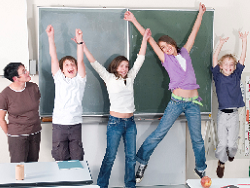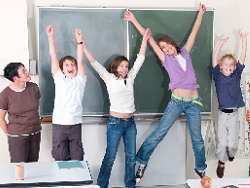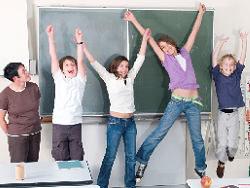


Summer’s over and the crash, clanging and rumble of lockers, desks and students is heard in hallowed school halls again. Students catch up on summer reality shows, who’s hot, and who’s paired up with whom for homecoming. Meanwhile, teachers return to their quest of piquing the interest of sometimes already-jaded students and teaching them something. Here are a few quick and creative tips to break through the white noise.
Betsy Allen, the former senior vice president at The Bob Pike Group, is one of the main facilitators of the Research-based Creative Teaching Strategies—a scientifically-sound approach to student success. This course is based on more than 30 years of brain and learning research on increasing attention, retention and recall. She suggests getting more interactive and more creative (which doesn’t necessarily mean a lot more work) to help kids process and retain information without them realizing they’re studying—or getting tested.
“We need to get away from tests being about catching students being wrong and use testing to teach and affect learning,” Allen said. “Anxiety is inversely proportional to retention.” In other words, we are less likely to remember if we’re scared about something—say, a quiz or exam. “Strive to create a safe learning environment, where it is safe to make mistakes, to teach others what we know, and to assist each other in being successful by processing what we’re learning out loud.”
Allen suggests three quick ways for testing students in an unobtrusive way.
Crossword Puzzle: Students can complete a crossword alone or in pairs. This helps them review the information already covered and perhaps fill in gaps they missed along the way. By themselves, it’s an open book test, but fun way to learn; with a partner, it’s an interactive and perhaps synergetic learning tool.
Four Corners: Students are given four verbal multiple-choice options. Each corner of the room is assigned one of the answers—A, B, C, or D. The students go to the corner representing their answer. This is a great tool for students who are always tapping their pens or fee; they may be kinesthetic learners who learn better by having a small part of their body moving while learning.
Sequence Shuffle: Students create their own sequence of events—one part of the sequence per 3x5-inch card. Students then shuffle the cards and then put them into the proper order. If each student has different events to sequence, they can then exchange shuffled decks with a partner and put a new sequence in order.
“Very little learning happens in the ‘delivery’ of content,” Allen said. “The learning happens in the processing of content, so use creative testing techniques which reinforce learning and provide teachers with feedback on what students are understanding and what they still find confusing. Ultimately, do I as the teacher have to confirm individual strengths/weaknesses and comprehension? Yes. The point is to make it a safe process, so kids are learning for life, not just learning to pass a test.”
Don't miss out on updates and chances
to sharpen your skills with participant-centered learning.




3740 N Chestnut St #113 - Chaska, MN 55318-3053